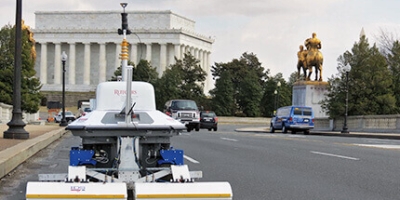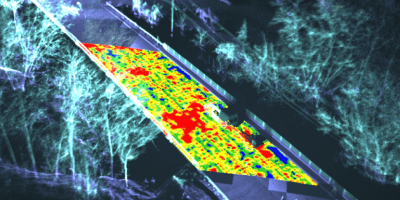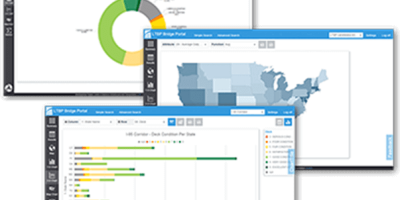Rutgers CAIT is working with USDOT to develop the Advanced Bridge Technology Clearinghouse — a digital “one-stop-shop” for technically robust information on the latest innovations in bridge engineering.
As the nation’s infrastructure ages and faces additional stresses from increased traffic loads, there is an urgent need for innovative solutions that can ensure the long-term safety and performance of these structures. The Advanced Bridge Technology Clearinghouse (ABTC) will provide the bridge industry with a platform for efficiently identifying and promoting new bridge technologies from paper into practice.
The platform will use Artificial Intelligence (AI) to rapidly scan and evaluate extensive bridge data and publications. In addition, a team of industry and academic experts has been assembled to manage the platform — manually checking all database entries, ensuring accurate technology evaluations, and providing tailored responses to user questions.
Once developed, ABTC will be able to provide transportation professionals with AI-driven insights, well-defined performance metrics, and rigorous safety evaluations of advanced bridge technologies that can enhance critical activities from construction and design to monitoring and maintenance.
Industry Snapshot
There are more than 600,000 bridges across the United States that play a critical role in supporting the nation’s economy by connecting regions and cities, workers to jobs, goods to markets, and people to essential services.
In 2024, more than 4.9 billion motor vehicle trips were taken daily across the nation’s bridges, slightly more than the daily trips recorded in 2021. Of these bridges, 49.1% are in fair condition, 44.1% are in good condition, and 6.8% are in poor condition — a number that has continued to decline in recent years.
Aging infrastructure and traffic growth demand urgent innovation to ensure that the nation’s bridges are maintained in a state of good repair and continue to perform. Implementation of new technologies has been a formidable challenge for the industry, as current bridge information is spread over many entities such as DOTs, municipalities, contractors, inspectors, reports, and publications, and is not readily available from one source.
Through a convergence of expert collaboration, rigorous evaluation, and proactive outreach, ABTC aspires to address this challenge by serving as the hub for bridge technology and best practices.



Meet the Team
The ABTC is supported through a cooperative agreement with the United States Department of Transportation (USDOT).

The Center for Advanced Infrastructure and Transportation (CAIT), within the School of Engineering at Rutgers University, develops practical tools and processes that can be implemented as mainstream tools in the hands of transportation professionals solving real-world problems right now. CAIT research focuses on assessing and monitoring the health of bridges, roads, and pipelines; creating revolutionary technologies, materials, and tools; formulating strategies to prolong the service life of infrastructure; and training the current and future workforce.
- PI: Nenad Gucunski, PhD
- Co-PI & PM: Maurizio Morgese, PhD
- Co-PI: Jessica Cheng, PhD
Personnel:
- Ali Maher, PhD
- Perumalsamy Balaguru, PhD
- Husam Najm, PhD
- Jie Gong, PhD
- John Braley, PhD
- Vassilina Demetracopoulou, PhD
- Dan Barone, PhD
- Tyler Oathes, PhD
- Shane Mott, MS
The Texas A&M Transportation Institute (TTI) is an agency of the State of Texas and a member of The Texas A&M University System. For 70 years, TTI has addressed complex transportation challenges and opportunities with innovation, objectivity, and technical expertise. TTI delivers practical and innovative solutions to improve the movement of people, data, and goods through research, education, and technology transfer.
Personnel:
- Amirali Najafi, PhD
- Stefan Hurlebaus, PhD
- Gregory Winfree, JD
- Jean-Louis Briaud, PhD
- John Mander, PhD
- Maria Koliou, PhD
- Jeffrey Bullard, PhD
- Anna Birely, PhD
- Bahar Dadashova, PhD
- Zachary Grasley, PhD
- Stephanie Paal, PhD
- Anand Puppala, PhD
- Petros Sideris, PhD
- Kinsey Skillen, PhD
Prairie View A&M University is the second oldest public institution in Texas and a member of the Texas A&M University System. PVAMU is home to the National Center for Infrastructure Transformation (NCIT), a USDOT University Transportation Center focused on improving the durability and extending the life of transportation infrastructure for years to come through its research, education, and technology transfer programs.
Personnel:
- Judy Perkins, PhD
- Abdul Choudhury, PhD
- Ramalingam Radhakrishnan, PhD
Arizona State University is a comprehensive public research university dedicated to the simultaneous pursuit of excellence in education, conducting research that has meaningful public impact, and furthering innovation. ASU is regularly ranked #1 for innovation among colleges by US News & World Report and is home to leading research centers on transportation and geotechnical engineering.
Personnel:
- Narayanan Neithalath, PhD
- Barzin Mobasher, PhD
Michigan State University is a premier land-grant institution. MSU is home to the Composite Materials and Structures Center, which is one of the foremost facilities for the study of polymer composites and is internationally recognized for its contributions to composite science and structural engineering.
Personnel:
- Nizar Lajnef, PhD
- Qingxu “Bill” Jin, PhD
The research team is engaging leading practitioners from top companies as Industry Partners.
- Hooman Parvardeh, CEO, AssetIntel

